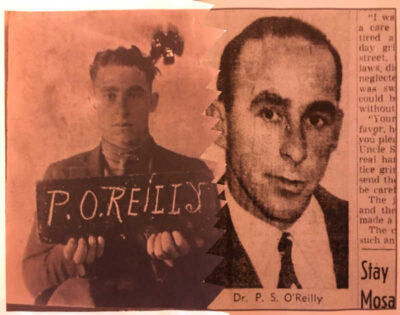The Hidden Identity of Dr. Patrick O’Reilly
This article is the first of several planned articles on the Mysterious Dr. O’reilly and is a necessary summary & introduction to the hidden life of this Black Dahlia suspect.
▶️ YouTube video including this article is available at: https://www.youtube.com/watch?v=emDlCIlBFLk
The 1951 suspect list by lieutenant Frank B. Jemison lists “Doctor Patrick S. O’Reilly” as suspect #21 of 22. He is listed due to his reported friendship with fellow suspect Mark Hansen, for having spent time at the Florentine Gardens, and for having attended “sex parties” in Malibu, in addition to attacking his secretary in the past and for being a surgeon who had “His right breast…removed by surgery” likened onto how the killer removed Elizabeth Short’s right breast.
When I looked into the life of Dr. O’reilly, I quickly found myself a bit perplexed. Digging through Newspapers, Census Reports, and Voter Rolls, I could not find any conclusive evidence that this individual existed before a 1924 voter registration decades after his birth. You won’t find Dr. O’reilly’s Birth Certificate. You will not find O’Reilly on any census in his youth. You will discover nothing. And there is a reason for this. Before 1917, Patrick O’Reilly did not exist.
Going down a rabbit hole of records, I found a hidden life full of lies and with numerous plot twists.
While I think that a deeper dive into this little-known suspect in the Black Dahlia murder reveals many more reasons to wonder if he could have been the killer, if anything, you will see that Dr. Patrick Shane O’Reilly was much more than the police were aware of at the time.
Rather than going back through the tangled web as I had to do, I will start at Dr. O’Reilly’s true beginnings.
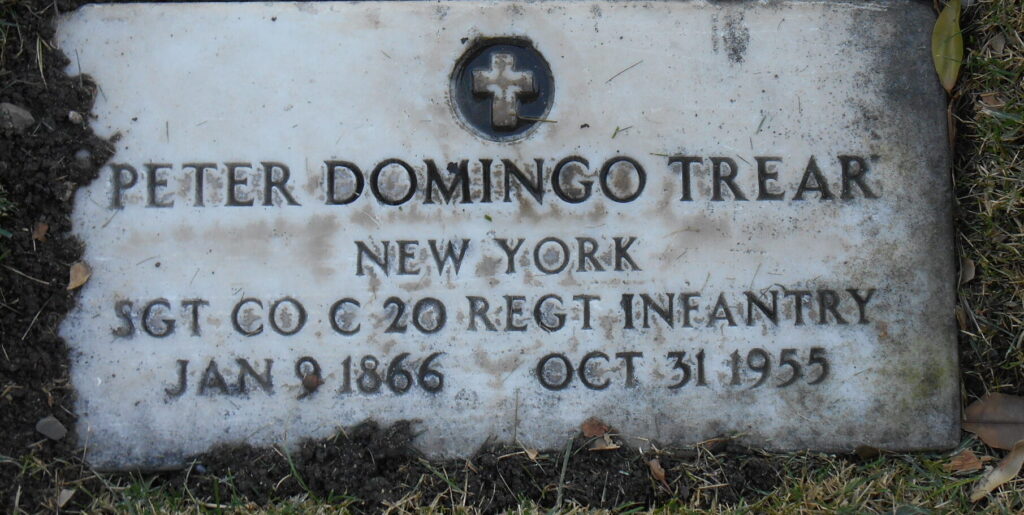
First, I introduce you to Peter Domingo Trear (born Jan 9th 1866), a storekeeper at the prison in Leavenworth, Kansas. Peter, and his wife Albertina (Jan 1865 – June 9th 1915), had three children; two daughters, Mary & Frances, and one son, Patrick, who was born March 17th, 1900. This Patrick, from Kansas, was in fact, the individual we now know as Dr. O’reilly.
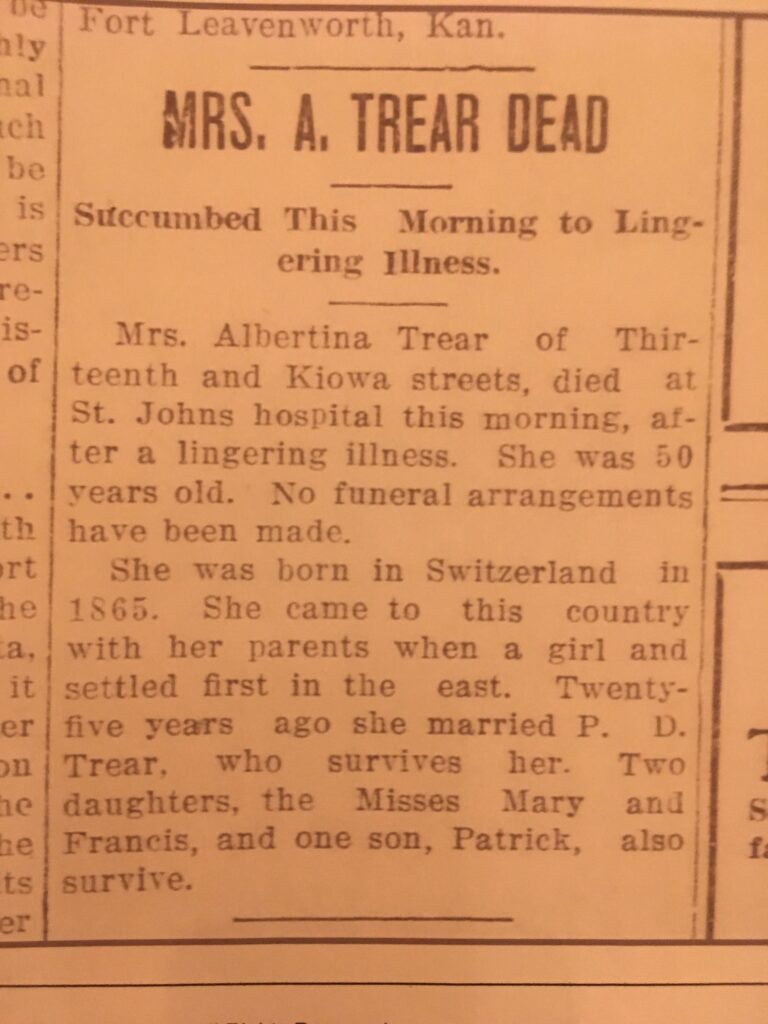
While there are essential happenings in Patrick Trear’s early life, let’s jump ahead to when he was 16, in 1916. Patrick supposedly tried & failed to join the US Army. His father, Peter, a military veteran, wouldn’t allow his only son to get roped into the horrors of war at such a young age. Aiming his sights at the Kansas National Guard, Patrick devised a plan. Running away from home, he told the Kansas Guard a fantastical tale.
In 1916 the United States was at war with Mexican Revolutionaries along the southern border. Patrick Trear told the Kansas National Guard that he was not only an orphan born in Ireland, complete with a phony Irish accent, but also someone who had lost both parents to the very same Revolutionaries. The tale that he wove was something out of a modern horror film. Simultaneously earning sympathy and stoking the flames of anger against the Mexican rebels. Patrick told the Kansas Guard that his parents had gone to Mexico for a trip. While there, the Mexican rebel soldiers killed his father and “bound his mother across a cactus plant and tortured her by shaking the plant until she died from the wounds received.” Patrick said he ‘craved revenge against the Mexicans for what they did to his parents.’
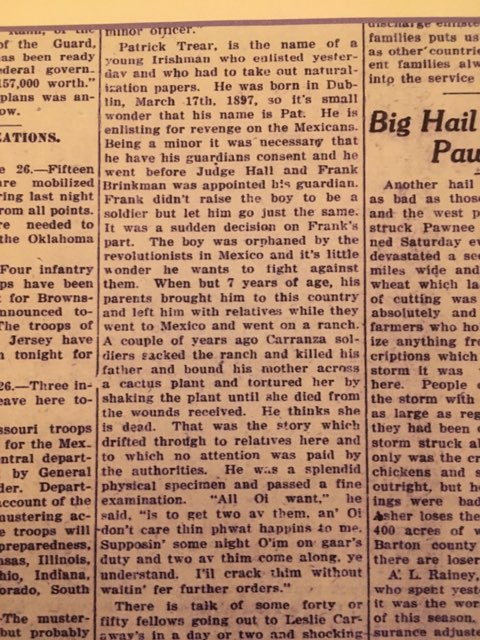
With no parents to allow for his enlistment, a Kansas National Guard officer, Frank Brinkman, became Patrick’s legal guardian so that he could join them. Little did Mr. Brinkman know, nor Judge Hall who granted the guardianship, that Patrick Trear was born in the United States and had a father who was alive & well in the very same state. Patrick had lost his mother, but as seen in the first newspaper clipping, it happened the previous year from an illness she had been battling for five years.
Now a Kansas National Guardsman with Company C, Patrick Trear went to Fort Riley before being deployed to the Rio Grande. As with many 16-year-old kids, the reality of an adventure was quite different from the fantasy Patrick built up in his head. The officers took issue with the young Patrick’s disdain for menial tasks such as chopping wood, carrying supplies, and being on guard duty. Having had a childhood of games, birthday parties, and enjoyable little summer jobs, Patrick wasn’t in tune with the rugged men who populated Company C’s ranks. Neither was he in tune with the adage when told by a fellow guardsman that he was a “hardhead”. Patrick comically challenged the man to see who really had the hardest head. They ran at each other like a pair of headbutting Rams. No surprise that young Patrick’s only reward was a large gash above his eye.
While I am sure the injury led to quite the commotion of laughter among his comrades, more fantastical tales would spearhead the injury into the newspapers.

KANSAS SOLDIER SHOT… MEXICAN SHOOTS US SOLDIER… SOLDIER NEAR DEATH…
Such were the headlines in dozens of newspapers across Kansas, Iowa, Oklahoma, and elsewhere. They all spoke of the heroic and narrow escape of young Patrick Trear from the gunfire of the enemy. The imaginative Patrick seemed to want to tell his friends back home in Leavenworth of his adventures along the southern border. As chopping wood for campfires was not an exciting story, Patrick turned his silly game of headbutting into a harrowing tale.
Patrick told them he had been swimming in the Rio Grande when the enemy suddenly opened fire. The Mexican sniper hit their target, shooting Trear in the head. The “soft-nosed” bullet sheared off his skull and lodged in his jaw. The bullet knocked him unconscious, but a fellow soldier saved him from drowning.

That fairy tale bullet earned Patrick the nickname “Hero of the Soft-Nosed Bullet.”
Once this tall tale circled back to Trear’s commanders, they were less than pleased, and they had to put water on the fiery story making its way across the nation. Patrick ended up back in his hometown of Leavenworth, not as a hero but as the brunt of a joke. For several months from 1916 and into 1917, his name appeared in local papers, paired with tongue-in-cheek references to his tall tale, such as deeming his muffins from a cooking competition as potentially fatal bullets.
One would think after such humiliating publicity, Patrick would lie low. But instead, he was out to redeem himself.
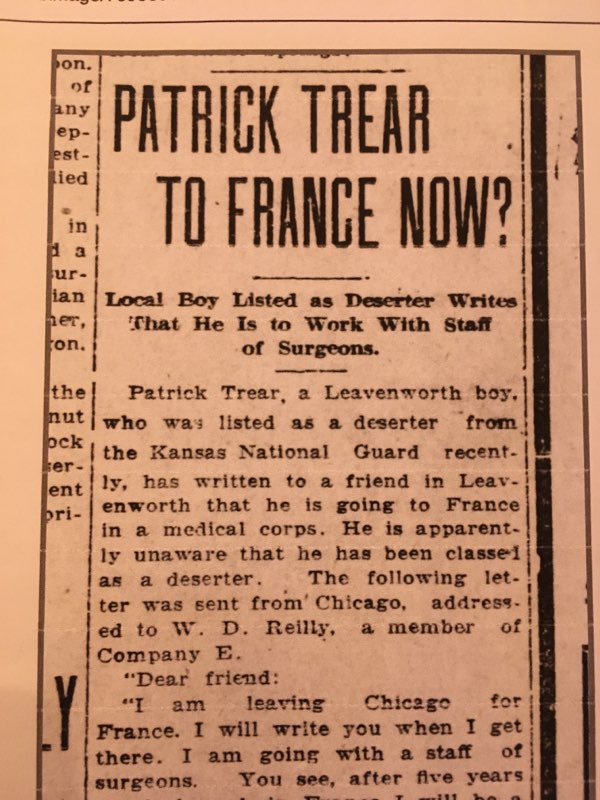
In April 1917, the United States entered World War I, and Patrick was still eager to join the military. However, whether it be his father still refused to sign off for his son to fight or the newspapers deemed Patrick a deserter from the Kansas National Guard, he had to look outside of the United States.
Still only 17 years old, Patrick managed to lie his way into the Canadian military in August, as Canada was also involved in WWI. Keeping to his previous lie, Patrick told the Canadians that he was born in Dublin, Ireland, but embellished even more this time. Patrick changed his birth year to 1898 to make himself 19. Despite being a high school student, he listed himself as a Medical Student. Patrick hid his previous shenanigans stating that he had no previous military service. And this time, his name wasn’t Patrick Trear, but instead told them he was Patrick O’Reilly. Thankfully for us, he made the mistake of listing his sister Mary Trear of Leavenworth, who was Mrs. Mary Leger at the time, as his next of kin. Believing his lies, the reborn Patrick was granted enlistment into the Canadian Expeditionary Force and given the military identification number 3030018.
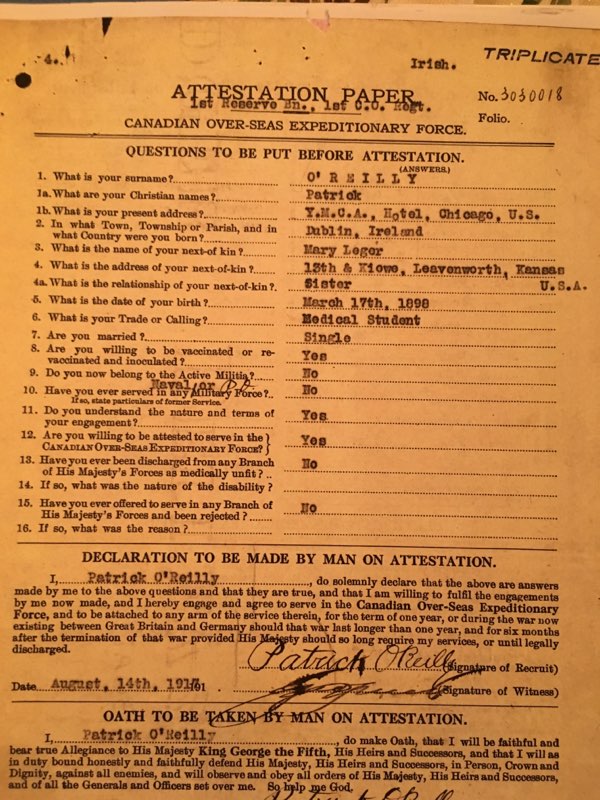
With the war raging and millions of people perishing, Patrick’s unit, which was coincidentally named the Princess Pats, was sent off to Europe. His experiences overseas are a tangled web all of their own, with potential lies and half-truths abounding, best left for another article. It is enough, for now, to say that he was in and out of hospitals for “epilepsy” for most of his tour of duty. There are many official documents about his hospital stays, including how he was pretty distraught over ‘the death of his parents at the hands of the Mexican rebels.’ He just couldn’t let go of his horrid made-up memories.
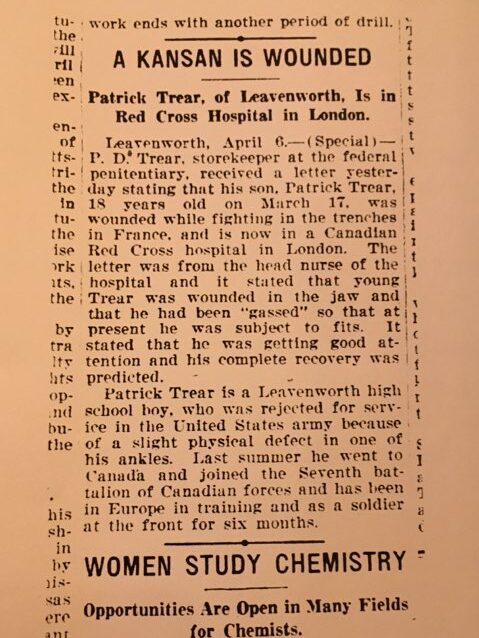
While there is no official evidence for it, the American newspapers told of Patrick, as Patrick Trear, as having been gassed by the Germans and wounded in the jaw by shrapnel. He was on the frontlines for a time in France, with virtually all of his medical records documenting Epilepsy, Scabies, and other illnesses. There was speculation on the part of a few doctors that he was suffering from Shell Shock, but there is no record of him having been gassed nor wounded in battle. The papers got wind of his supposed war injuries thanks to his sister Mary with whom he wrote. Mary must have known of his lies, seeming that the letters would have been from Patrick O’Reilly and not from the name her brother grew up with, Patrick Trear.
In May 1919, Patrick as Patrick O’Reilly was discharged from the Canadian military as medically unfit. No longer in the care of the Canadian armed services, he sought to return to his home country. But Patrick didn’t want to return as Patrick “Soft-Nosed” Trear. No, he wanted to return as the renewed Patrick O’Reilly. For this, he would turn to his other sister, Frances, who was now Mrs. Frances Marsales and was living in Los Angeles, California.
In June of 1920, Frances Marsales attested on a United States Shipping Board Affidavit that her brother, Patrick O’Reilly, had lost his birth certificate. While accurately affirming that she was Patrick’s sister and that he was a US Citizen born in Kansas on March 17th, she lied on his behalf, saying that his last name was O’Reilly and that he was born a year earlier in 1899.
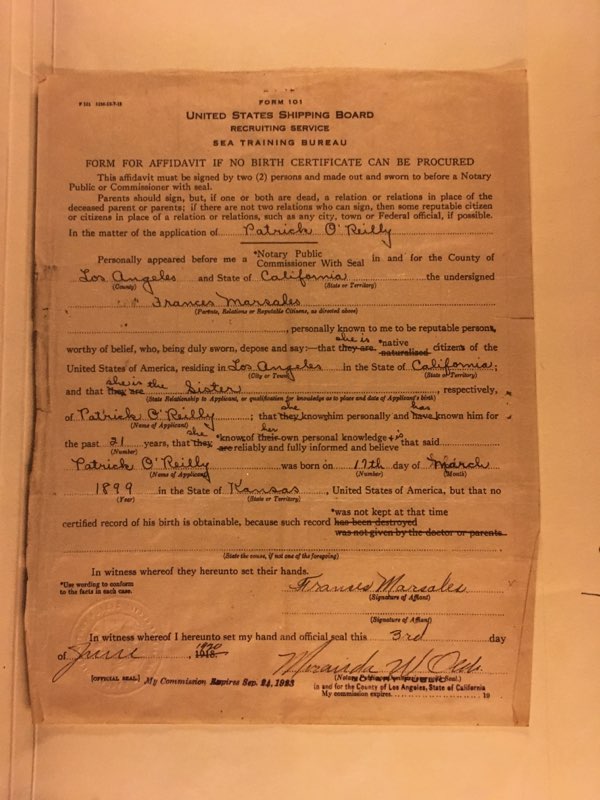
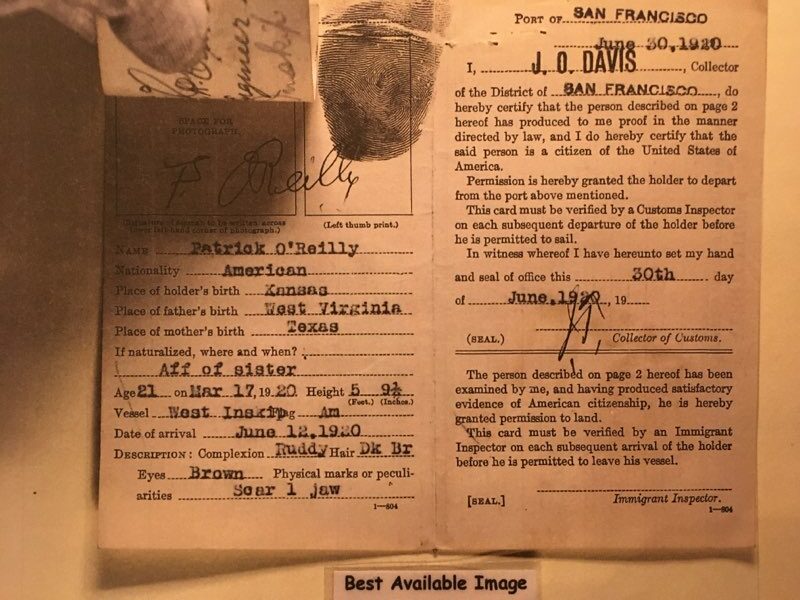
Using this illegally obtained affidavit, Patrick received legal identification in the port of San Francisco 27 days later under the name of Patrick O’Reilly. The only identifying mark mentioned on the new ID was that he had a scar on the left of his jaw.
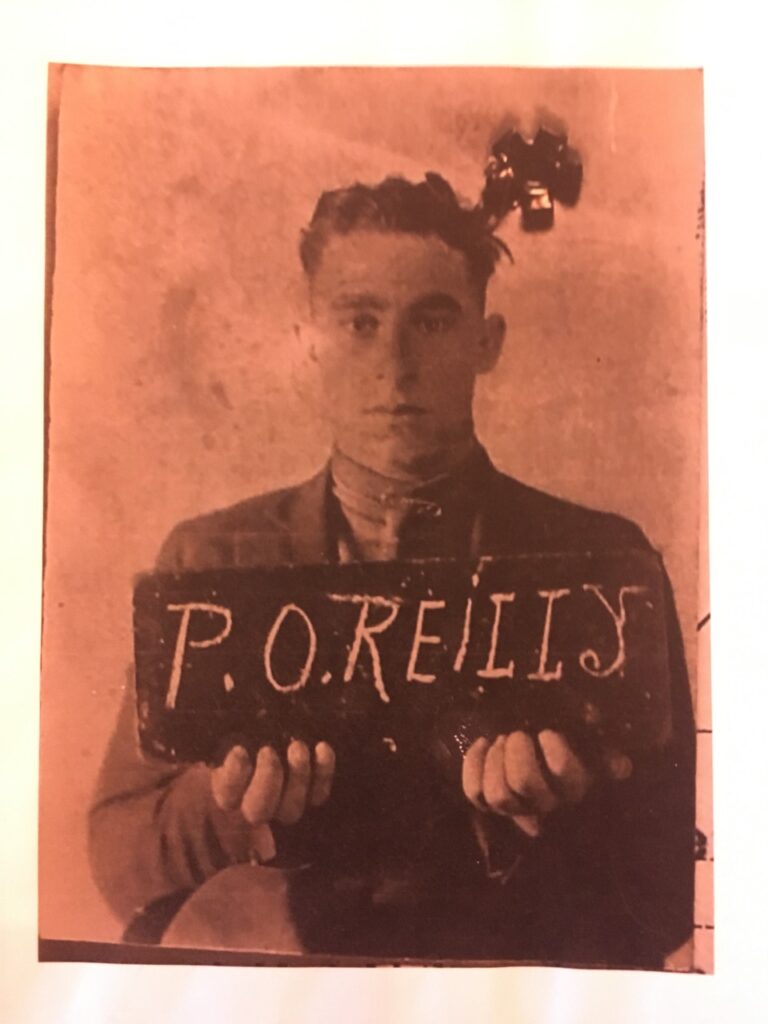
Now comes the question of how we know that this specific Patrick O’Reilly and his colorful past is the same Dr. Patrick O’Reilly who was a suspect in the murder of Elizabeth Short. Patrick O’Reilly isn’t exactly a rare name, after all. I could point to known photos of Dr. O’reilly and say he has a scar on his left jaw. But I am sure many people who were involved in WWI, of which Dr. O’reilly was admittedly one, had received facial injuries. We need something concrete that ties these two O’Reilly’s together beyond any reasonable doubt. And thankfully, we have just that.

Going back to the beginning of this article, Lt. Frank Jemison had listed the known address of each suspect on his list. The address paired with Dr. O’Reilly was 712 South Pacific. This address was the address of his hospital in Glendale, a suburb of Los Angeles.
In 1942 Dr. O’Reilly had to have a US military registration card filled out. In addition to listing his address as “712 S. Pacific” in Glendale, he recorded his place of birth as Leavenworth, Kansas, and his DOB as March 17th, 1900. In addition, the card listed identification marks. And these were a “scar on left of jaw” and a scar on “right eyebrow.” The latter would bring one’s mind back to the soft-nosed bullet, a.k.a. the little headbutt incident. But this is different from the document that seals the deal.
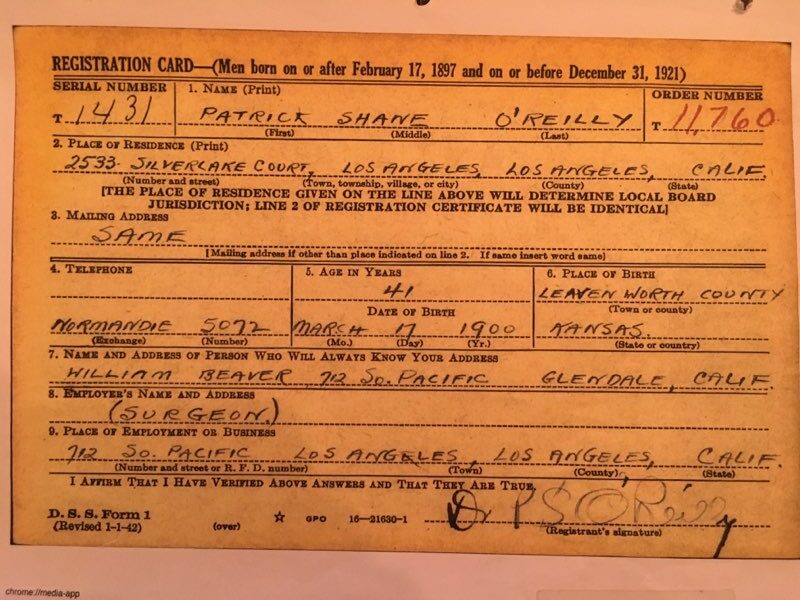

The Canadian military would send out small documents to veterans noting their service dates, unit, theater of war, etc. Having been in the Canadian military, Patrick Trear as Patrick O’Reilly would have been sent one, and indeed he was. Remember that every soldier received a special number which was unique to them, and Patrick’s was 3030018.
Among all of the Canadian military documents for number 3030018 is a copy of the small document sent out to Patrick O’Reilly with that exact number written. It lists his unit as the Princess Pats. It lists the theater of war as France. But it is the following detail which is the most important piece:
“Latest Address… 712 S. Pacific Ave. Glendale Cal. USA”
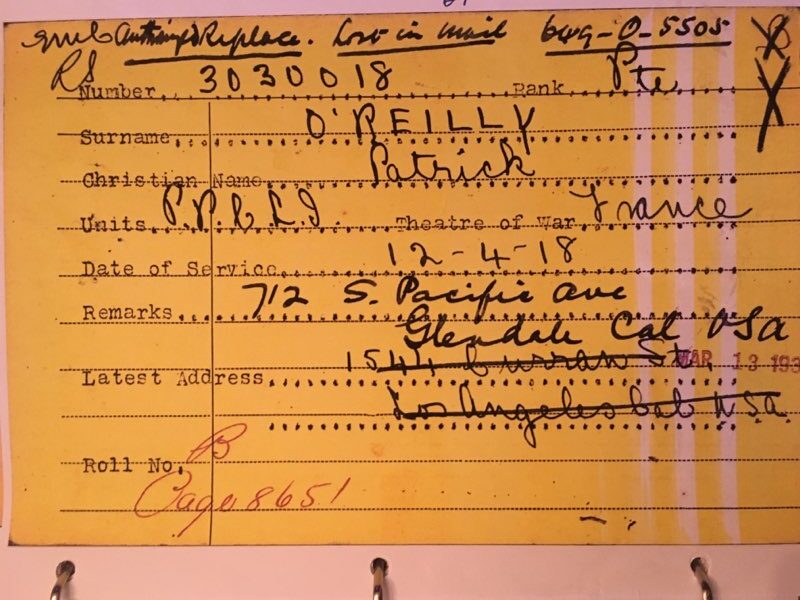
Note: This document is from the Canadian military records and was corrected by Canadian authorities.
Without a shadow of a doubt, Patrick O’Reilly, #3030018, Hero of the Soft-Nosed Bullet, brother of Mary Leger-Trear, brother of Frances Marsales-Trear, son of Peter Domingo Trear, was the same Dr. Patrick O’Reilly who worked at 712 South Pacific Avenue and was the suspect in the killing of Elizabeth Short.
Now that I have shown that Dr. Patrick O’Reilly and Patrick Trear are the same, I can offer you in future articles why Dr. O’Reilly is a much more credible suspect than initially meets the eye. There is much more to O’Reilly’s story than has just been shown and connections that have thus far been overlooked.

